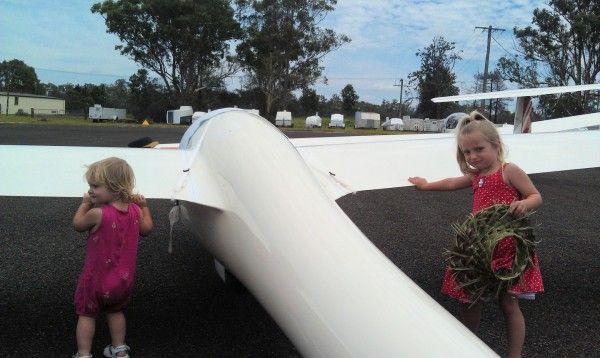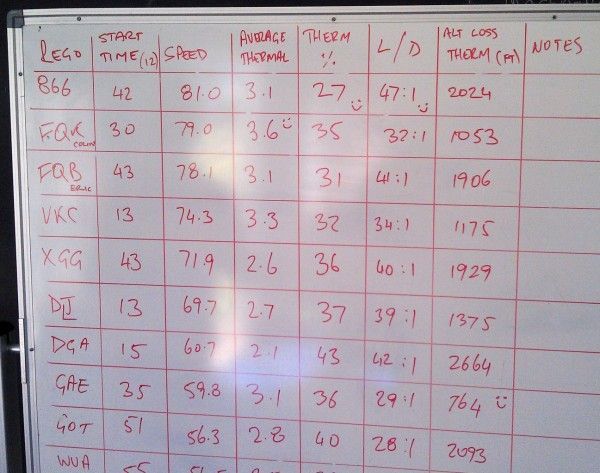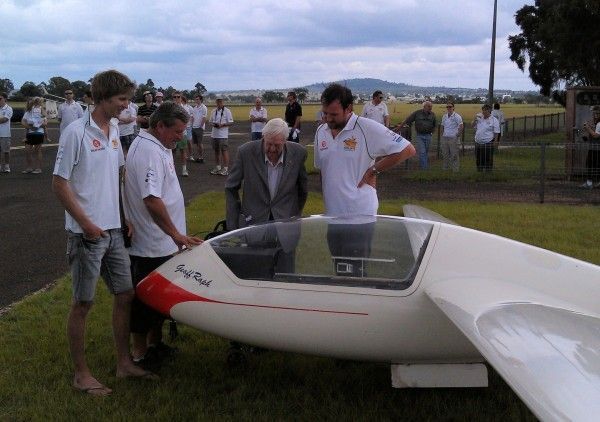Back to that write up from JoeyGlide 2011. The first few days seemed to leave some time to write and attempt to proofread. However as the contest got underway time seemed to go by faster. This was my first contest with all of the girls and after landing we would spend the rest of the afternoon playing and preparing for the evening de-brief. So I would like to highlight some of the things that made JoeyGlide stand-out.

Hospitality: When Adam Woolley* mentioned we should come to JoeyGlide there were a lot of logistical issues. The monetary issues were taken care of by the IRS politely returning some of our money, which was roughly the amount of the airline tickets. Adam had arranged a family room with an en-suit for us at the Kingaroy Bunkhouse which was the old hospital from WWII. He also loaned us his car, which allowed Renee and the girls to run around while I was flying. He picked us up at the Brisbane airport and we had “tucker” (dinner) at Adam’s parents house. The next morning we assembled Adam’s Cirrus 75 and rotated gliders in the hanger so I could slide the Cirrus in and out. Jim Crowhurst (Remember the original internet gliding video UK Smoking?…yea…him) had brought toys for the girls and gave us a place to stay after the contest.
Daily de-briefing: JoeyGlide is also modeled around a soaring camp idea and after a day of flying, dinner was prepared on the field every night, Bobby did an excellent job cooking for all. Most of everyone was staying on the field. After dinner we had a de-brief, which was run by Jim and I, we flew the task everyday so we could give feedback to the Juniors about what we thought of the task, day, weather, decisions…I was really hoping that I could have shown them how to do it…But Andy Maddocks along with others were doing very good. We had a ‘Board of Truth’ where we listed: Start Time, Speed, Average Thermal, thermal %, L/D, Alt. Loss Thermal, # of tries, % Left/Right. One of the most remarkable things we found from this is that Michael Conway at his first contest routinely had the lowest altitude loss while thermalling. It was a fun novelty to look at and see what pilots could work on, centering, better energy lines, etc. We also ran a maggot race with SeeYou and talked over the decisions that everyone made. This generally led into some very good discussions.

Troy’s landout. I am hoping that a write-up will make it here soon. The retrieve rivals the return of Al Tyler from his landout in Serbia at the last WGC in 2010. However Troy had twice as much mud. The coolest thing at a contest I have seen to date is when they returned with the Astir the following evening after the de-breifing, the entire clubhouse emptied and the music carried into the hanger. The entire group was there helping out. The Astir was effectively given an annual inspection, the wings were washed, waxed, and lubed. The rudder was removed and the mud was washed out. The gear, towhook, seatpan were all removed and cleaned. One of the coachee’s had the power-washer and last I saw he was climbing into the trailer and a mist of cold water was streaming out the back end. Around midnight the majority went to bed and Troy was on the line the next day.
Launching the juniors on beautiful British day: Adam wanted advice on what to do, I said lets launch them and see what happens. Anita Taylor gave a good talk on sports psychology while the gliders were waiting on the grid and we waited for the weather to improve. Finally we launched everyone into a great British sky, however cloudbase was not there, some rain, and it would not be fair to all. So Adam had to cancel the day. Then Jim and I got a few together and we made it into the first turn where there were about 6 of us down low, which was the biggest gaggle that some of them had flown in. However the second turnpoint was not practical and most retreated while they still could, a few did not return home via the air.

Scores were done with www.dittolog.com and posted on SoaringSpot.com you must check out DittoLog, it was amazing, a wireless IGC data logger. Once you land it sends a WiFi signal and if you are on the airport it starts to send the data via WiFi. If you land out it gives up, so you pop the DittoLog out of the aircraft, once returning to the airport, turn it on, it connects sends the info then turns itself off. There was no screen on the DittoLog, so a flight computer was a good idea. These are designed for club use, check out there website to see all of the things they can do, we just utilized a small part of what they can do.
There was an earlier mention about racing the Cirrus in club class. The appeal of no water-ballast, ability to land-out in most fields, ground handling that does not kill your back. The little girls could actually get the glider moving. You could unhook the glider off the car without breaking your back. You could tow it around the airport without fear of having 30meters of clear taxiways. Flying the Cirrus was like flying a little sports car, wonderful to fly, great handling. However to quote Michael Bird “TINSFOS- There is no substitute for span” I needed another week to get used to the difference in the glide angle from the Nimbus. There were a few days that I wish I had the Nimbus as I would probably not have gotten into the holes I did with the Cirrus. I am glad the direction the US Team committee took with their club class selection it is very different flying those gliders. For those that may remember I had a Discus 2ax before my Nimbus 3 and flew it pretty well…won Region 9 at age 23

* I met Adam at the first Joey Glide and came in second behind him. Then we flew together at the JWGC in HusBos, thanks to Facebook we reconnected. Adam was the CD and main organizer for Joey Glide this year. He talked his local club into hosting, his Dad scored, his Mom took care of anyone that needed it, including furnishing our room at the bunkhouse.






